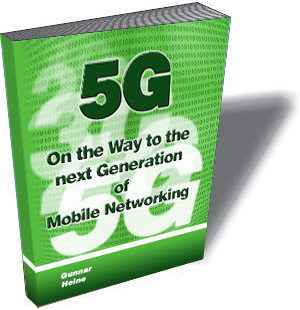Bookstore
5G - On the Way to the next Generation of Mobile Networking
Some of your questions that will be answered by this book:

- This course addresses the needs of technical engineering staff who require a thorough understanding of the evolution of the cellular and mobile networking technology towards 5G.
- The course has been designed to meet the requirements of operations, engineering and product management staff. It also targets technically encouraged marketing people, who require detailed knowledge about the upcoming 5G technologies.
- The course starts with a description of the envisaged timeline for 5G and the involved players. This part continues with an introduction of the technologies which enable 5G, namely filtered OFDM (5G NR) and the new architecture, namely the gNB-CU and gNB-CU and the NGC.
- We introduce the so-called functional split and depict the different options.
- The first chapter ends with a description of potential migration from 4G to 5G and the intermediate deployment options, the co-called NSA (Non Stand Alone).
- The next chapter is dedicated to the requirements and performance targets for 5G, coming from different organizations like the ITU-R or 3GPP themselves.
- 5G introduces new business options to the cellular domain, namely URLLC and an emphasized meaning of the IoT. However, we also look at the new understanding of the so-called eMBB.
- The following part of the course is dedicated to an overview of the current developments in the WiFi-market and the chances, competition and risks of and between the two technologies, WiFi and cellular.
- The description of 5G related deployment scenarios like dense urban, highspeed train or indoor hotspot completes this part of the course.
- The next chapter is dedicated to a deeper analysis of the envisaged first phases of the new PHY with 5G. This relates in particular to filtered OFDMA and its numerology. We elaborate the numerologies from 15 kHZ to 480 kHz in detail and present the most likely use cases, frequency bands, carrier bandwidths etc..
- One level above we present the new forward error correction techniques polar coding and LDPC and compare them with turbo coding and convolutional coding.
- The next chapter is dedicated to the 5G-network architecture which is largely driven by virtualization to reduce latency, time-to-market and cost and to increase flexibility and new business opportunities (Xaas). This part contains a practical example of virtualization plus an introduction into SDN and OpenFlow.
- The architecture related chapter also contains a detailed description of the different options of the functional split inside the NG-RAN and presents how eCPRI can be used to realize the functional split towards an RRH.
- We point out, how dual connectivity and different bearer types like MCG-, SCG- and split bearers can be used for the intermediate implementation of NSA.
- The NGC (Next Generation Core) with its different network functions is presented and how these network functions can be related to network elements.
- The final chapter depicts other interesting aspects of 5G, some which may be shifted to 5G phase 2, others which will be implemented earlier.
This relates to an understanding of “self-contained TDD” which enables much smaller RTT’s than in legacy TDD. - We also introduce the operation and characteristics of NOMA and how it operates through superposition coding and filtering.
- As a “wrap-up”, we look at the most likely options how WiFi may complement 5G most efficiently and most likely from the perspective of the market.
Product Details:
- Paperback / eBook
- 199 Pages
- over 70 Illustrations and Tables
-
Price Paperback: Euro 249.- (net)
-
Price eBook: Euro 199.- (net)
Download the order form and fax or e-mail it to us (inacon@inacon.de)

ℹ️ Try out the updated search below!
Search:
More Info:
General Infomation to this Book
Detailed ToC of this Book
INACON eBooks
Please have a look at our full offer

